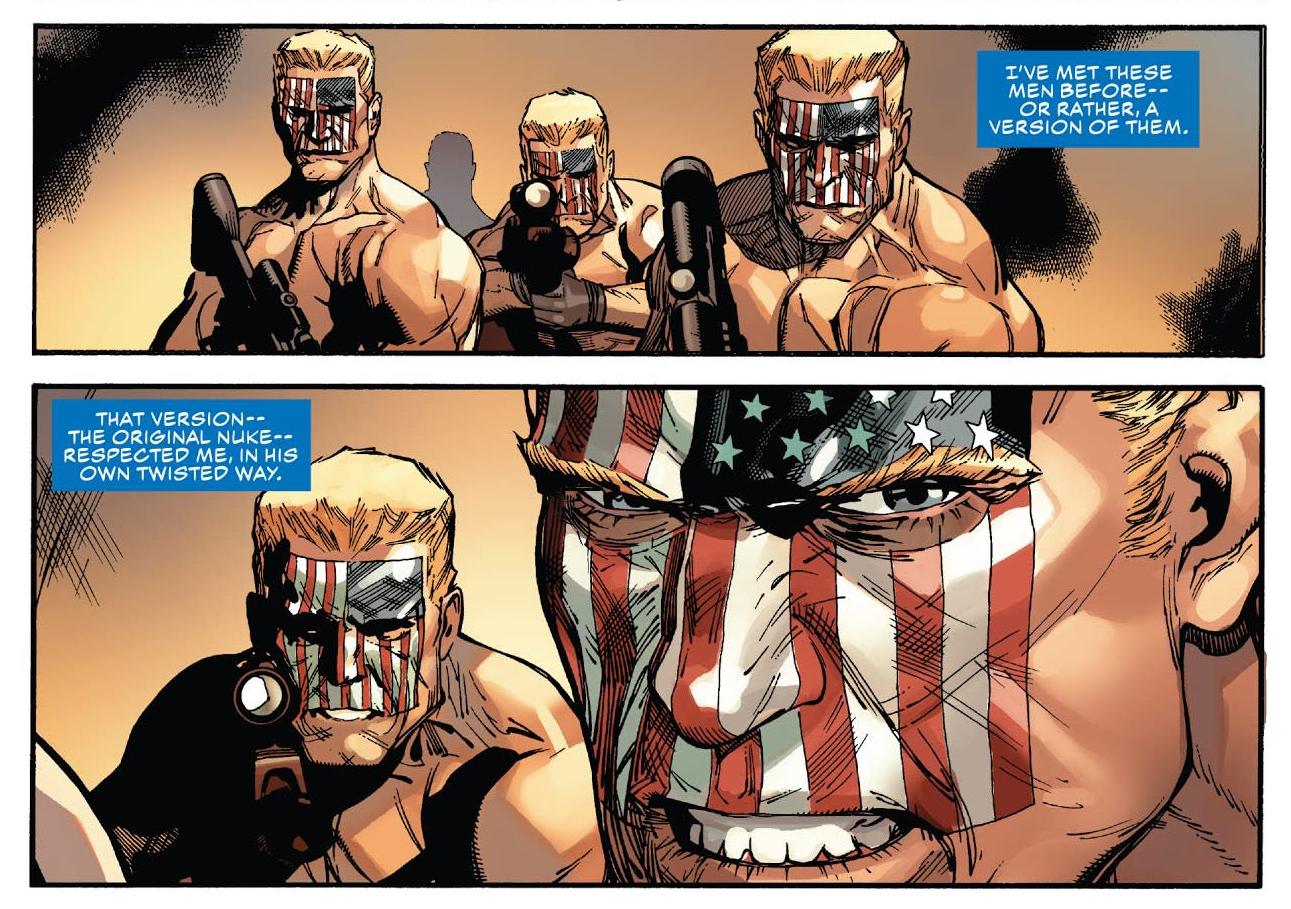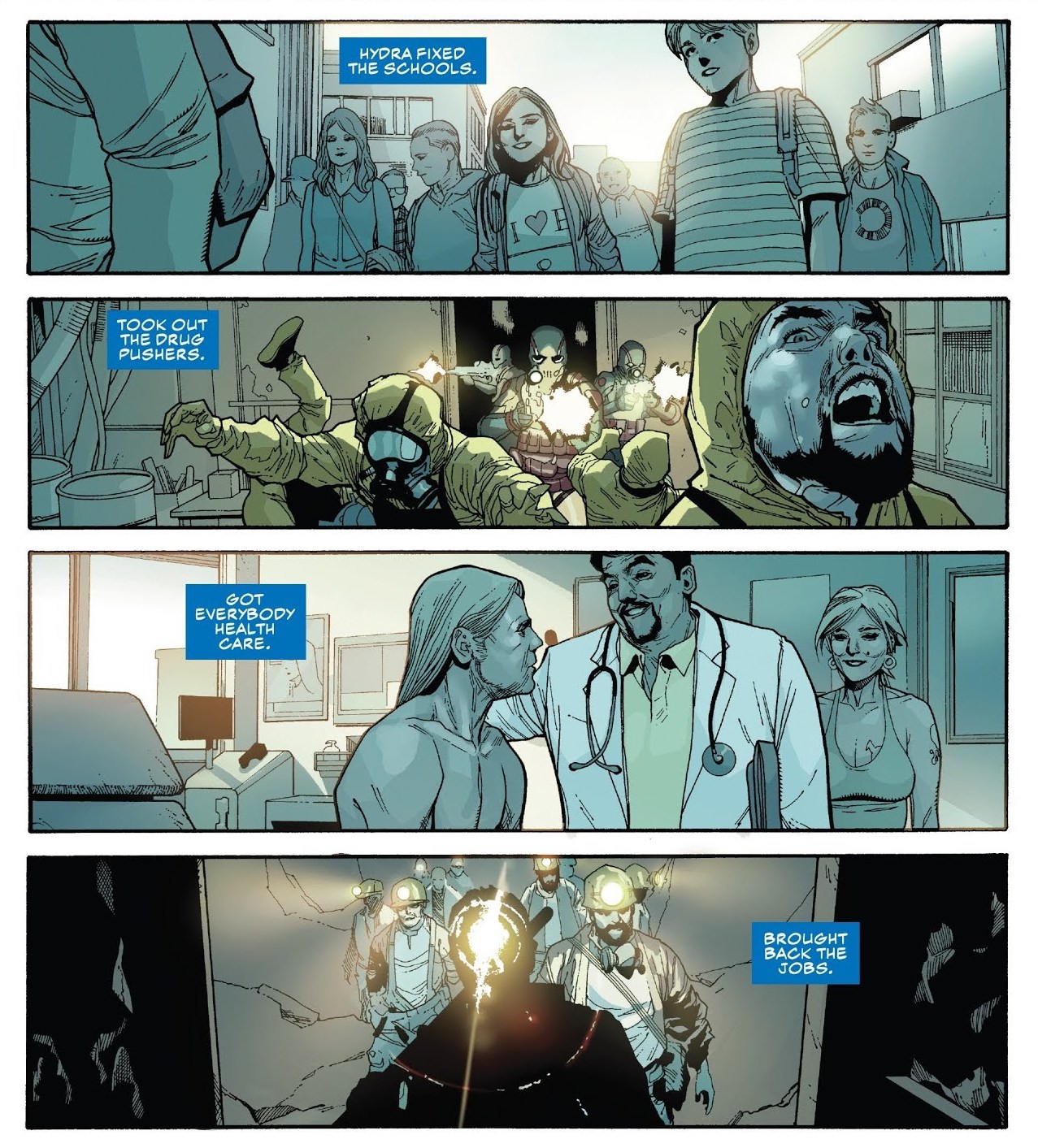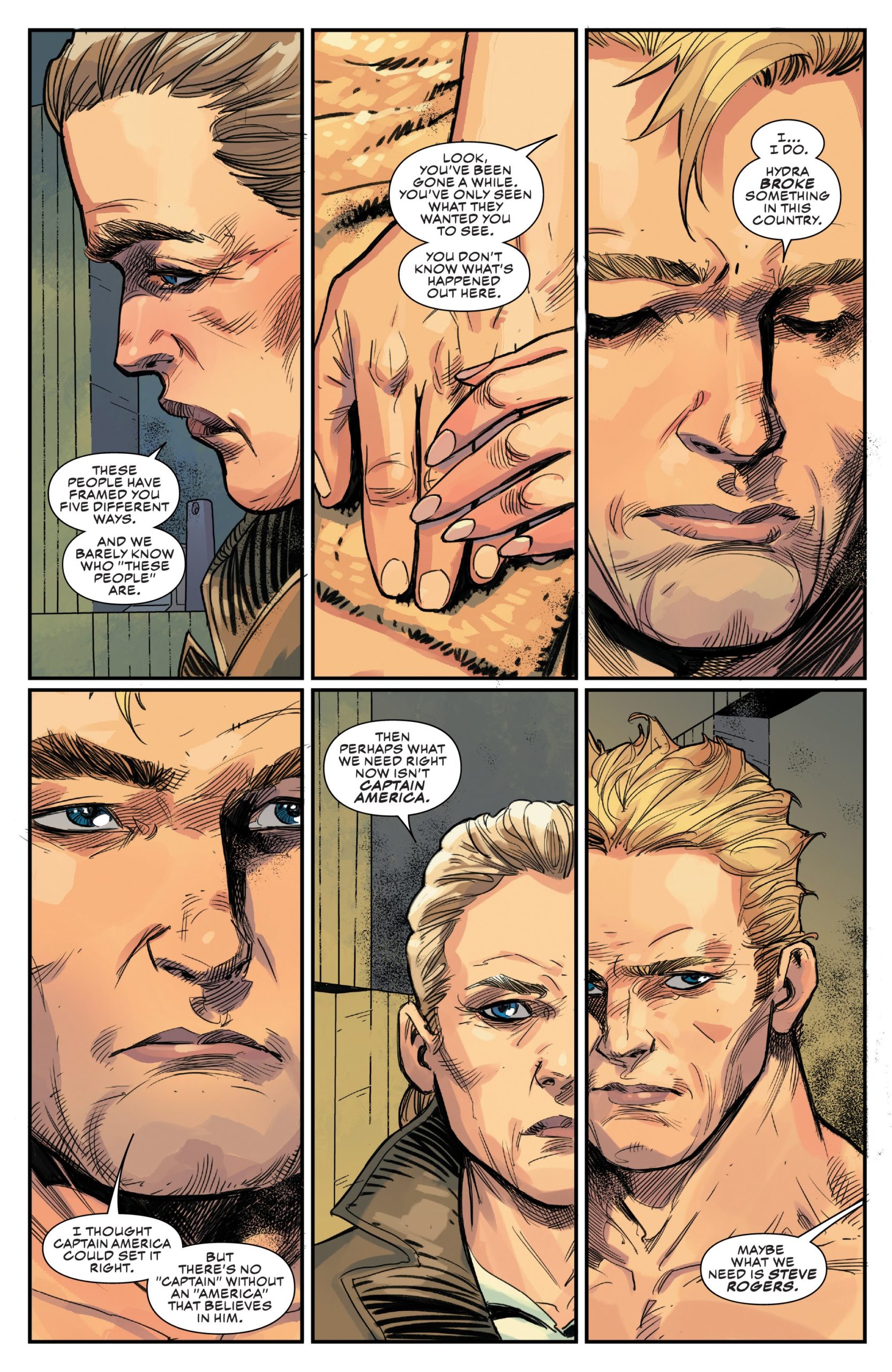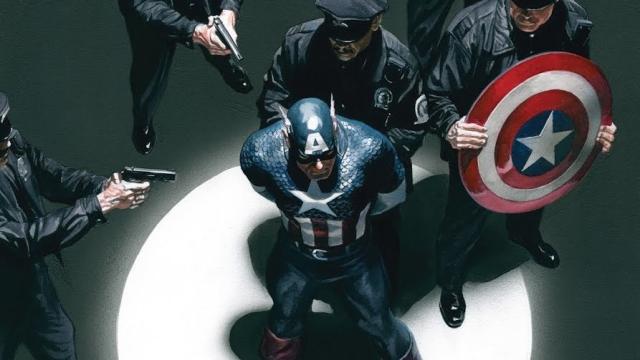Comic books and the movies, shows, and other media based on them aren’t always explicitly political, but both forms of art and their stories about heroes and villains are crafted by people whose worldviews are shaped by the political realities of the world we all live in.
When Black Panther writer Ta-Nehisi Coates took over Marvel’s Captain America series back in 2018, the fictional 616 universe was still reeling from the events of Secret Empire, the comics event that transformed Steve Rogers into the embodiment of Hydra’s fascistic power, and the organisation’s new leader. That same year, the Marvel Cinematic Universe’s Captain America — arguably the most recognisable modern incarnation of the character — was one of the few heroes left standing in the final moments of Avengers: Infinity War, a Disney movie whose shockingly bleak ending was a rather unsubtle acknowledgment of the real-world despair created by the political and social climate at the time.
Each of the MCU’s Captain America movies features the sort of broad thematic political commentary one might expect from a Disney-owned film studio. Captain America: The First Avenger, The Winter Soldier, and Civil War all centered ideas about governmental power and justice, but they were presented as stylised parables about good and evil that belied the true complexity behind the kinds of power structures they were explorations of. As much DNA as the MCU and its source material may share, comics as a medium have always lent themselves to much deeper characterizations and unpackings of the ideas running through stories like Secret Empire, and Coates’ run that’s followed the “good” Steve Rogers deals with the consequences of his dark other’s actions.

It was somewhat surprising when Marvel recently announced that Coates’ Captain America would be coming to an end this summer just after The Falcon and the Winter Soldier carried over some of the comic’s same themes to the MCU. But the comic drawing to a close at a time when Steve Rogers is questioning the dream he’s always sworn to defend and uphold are things people should genuinely stop to contemplate, both to appreciate Captain America as a series and to consider what the character really means today.
It would have been simple for Steve’s restoration by Kobik — a living fragment of the Cosmic Cube — to wholly erase the events of Secret Empire and allow Marvel to fit him neatly back into his Captain America identity. However, by keeping the version of the character who became Hydra’s supreme leader alive and kicking around in the world, Marvel primed Captain America to be a story about Steve having to face down the public’s complicated perceptions of him and his status as the country’s most iconic living symbol.
There’s always some question as to how much of the truth the general public knows about what superheroes get up to during the massive comic book events that must upend normal people’s lives on a numbingly frequent basis. Coates’ Captain America establishes that while people might not know the specifics about how Civil War II and Secret Empire played out, they do remember Captain America becoming Hydra Supreme and spearheading the organisation’s expansion and overthrowing of the American government. And though far stranger things have happened in comics, the world hasn’t forgotten how Hydra Supreme tricked most of Earth’s superheroes into space in order to enclose the entire planet in a dome to keep them out, ensuring they wouldn’t pose a threat to Hydra.
Recall how American Inhumans, many of them children, were rounded up and thrown into internment camps at the same time that mutants, who enjoyed a modicum of relative protection thanks to Magneto and mutants’ history of retaliation to persecution, were forced to relocate to New Tian (a region in California transformed into a mutant sovereign territory). They’re aware of the atrocities Hydra committed with Steve Rogers’ face, but many of them also recall the ways that Hydra fulfilled some of its poisoned promises for a new era of American prosperity. Even though the original Steve’s no more directly responsible for his counterpart’s actions than he is anyone else’s, Captain America opens with him grappling with guilt and anger about what Hydra did because he cannot deny that he and Hydra Supreme share a common existential origin.

More than a mere clone, Hydra Supreme was the result of Kobik creating an idealised version of Steve situated within an alternate reality in which he was indoctrinated into Hydra as a child. Like most of his fellow Avengers and the different superspy-staffed organisations he tends to work work, Steve’s well aware that evil versions of people from dystopian realities pop up fairly frequently. But Coates’ Captain America pointedly asks what that means for someone like Steve who comes back to a world that’s both trying to return to “normal,” and haunted by what normal was up until very recently.
Whatever understandable apprehension Steve feels about using his old title more or less evaporates as Captain America’s first arc “Winter In America” opens with him and Bucky taking on a swarm of cyborgs based on the original Frank Simpson, the deranged patriotic villain known as Nuke. Though the American government would rather Steve stay out of the spotlight given how little time’s passed since Hydra’s presumed fall, heroism’s been one of the few things still anchoring his sense of self — he’s repeatedly pushed to question who he is and what kind of person he wants to be.
[referenced id=”812751″ url=”https://gizmodo.com.au/2014/09/a-robotic-3d-printer-could-print-anything-anywhere-it-wants/” thumb=”https://gizmodo.com.au/wp-content/uploads/2014/09/18/o5xyxfbtew8a5dficj1y-300×136.gif” title=”A Robotic 3D Printer Could Print Anything, Anywhere It Wants” excerpt=”3D printers are far from a perfect technology at this point, but one of their most glaring issues is that their printing capacity is limited to the size of the machines. The print head on a 3D printer can only travel so far, which is why moving it onto a…”]
Captain America frames Steve trying to get back into the swing of things as a problem unto itself that gets at a facet of all comic book stories set after world-changing events. Even if Hydra Supreme were to remain behind bars and never terrorize the world again, the comic asks, what all would that entail exactly? Steve can’t deny that when people see him in his own classic uniform, what they’re seeing is the man who once personified a righteous sense of equality and humanity that extended beyond his explicit ties to the United States, and then became the ultimate super-Nazi before the world’s eyes.
Steve’s deep need to use himself as a shield to protect the vulnerable puts him at familiar odds with others in positions of authority who serve to complicate the important work he ends up doing to neutralise Hydra. Of course Hydra never truly goes away, and resurfaces in Captain America in Russia with frequent X-Men villain Selene now lurking in their leading ranks. Nefarious as Hydra and Selene’s larger plan is, it’s the way the organisation’s profoundly impacted some people’s perspectives that poses the most pressing and fascinating obstacles for Steve and his allies. To some, Hydra’s rule meant a positive change in the form of food, housing, and jobs brought to towns across the country that’d been suffering under previous political regimes. Evil though Hydra was and continues to be, it delivered on the dream promised, but never fulfilled, for Americans by their government — one that spent decades pointing to Captain America as proof of its heroism.

All of this makes the string of attacks on American soil that pull Steve back into action that much more complicated. It’s also a big part of why his longtime colleague and romantic partner Sharon Carter insists on taking point while he falls back and lets everyone who’s not Captain America deal with the matter at hand. What’s made the current Hydra such a compelling villain for Steve and his allies to rally against in Captain America is the simple fact that they were able to follow through on enough of its promises made to the public. What if it convinced them Hydra’s methods were worth it?
The parallels between Hydra’s recent machinations in Marvel’s comics and the real world Republican party’s larger project of cementing its grip on political power through systemic disenfranchisement, obstructionism, and abject lawbreaking are immediately obvious and part of a longstanding history of comics reflecting reality. But Coates’ Captain America understands that rather than just depicting Hydra Supreme as the superpowered ubermensch Donald Trump seems to fancy himself, it’s far more interesting and necessary to focus on what it means to live in a world where people openly pine for fascism.
Part of what made Hydra Supreme an effective leader is that he, like Steve, felt his convictions strongly and saw them as being rooted in a morality that was uniquely American. It’s discomfiting for some to think of America as a place where fascism and racism are celebrated and encouraged by people from all walks of life who are indoctrinated into a system that normalizes those evils. That discomfort stems from a lack of desire to accept the basic truths: that those things are every bit as American as is the rest of the country’s ugly, bloody history that people like to pretend we’re so far enough removed from that we no longer need to address and reconcile it. That discomfort is an important factor in the internal fight playing out within Steve in moments where he’s forced to consider what being Captain America means for him, specifically, as a person.

Much as Coates’ Captain America story has featured its fair share of wild plot twists you’d expect to see in a comic about a man fighting a mutant witch who eats people’s life forces, it’s also trying to show readers what it actually looks like for an American — a white man in particular — to ask themselves what it is that they grew up pledging allegiance to. Even if Selene and Hydra Supreme were no longer in operation and trying to seize control of the world once again, it wouldn’t change the fact that Steve Rogers, and America by extension, had the capacity to become the very things we like to think of as being antithetical to the United States.
In its final issues, there are multiple places that Captain America could leave the original Steve Rogers, but it doesn’t seem likely that the arc will end with his having settled on any one definitive answer to the question of what Captain America means to anyone but himself. That’s something that the rest of the world has to figure out for itself, too — not just by consuming whatever stories about Captain America Marvel puts out next, but by really thinking about it and drawing their own conclusions.
[referenced id=”1675691″ url=”https://gizmodo.com.au/2021/02/a-superman-solo-film-is-on-the-way-from-ta-nehisi-coates-and-j-j-abrams/” thumb=”https://gizmodo.com.au/wp-content/uploads/2021/02/27/zrwmpmle0tnxnbylzw1o-300×169.jpg” title=”A Superman Solo Film Is on the Way From Ta-Nehisi Coates and J.J. Abrams” excerpt=”A new Superman movie is finally in the works from a superhuman team of talents.”]
